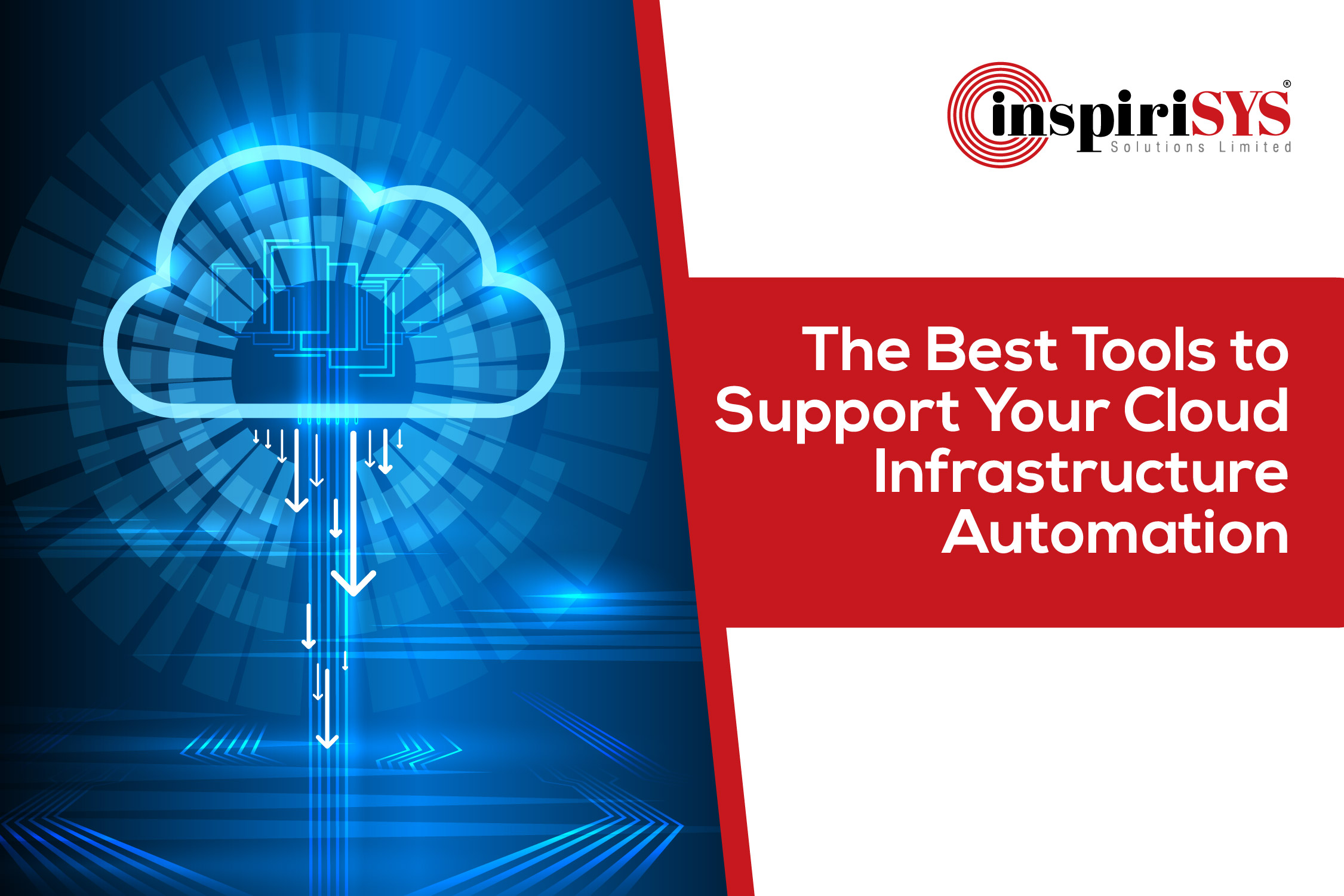The traditional, manual process used by enterprises is time consuming and labor intensive. This is because these tasks and processes are typically repetitive, and prone to human errors. Even a minute mistake or misconfiguration can lead to a breach of security and loss of important data.
Enterprises have long been considering shifting to the cloud to avoid such risks. With Cloud Infrastructure Automation, organizations can control their workflows and complete these manual tasks consistently and securely.
Cloud Automation allows enterprises to keep a watch on all the resources being used. It identifies, predicts and maintains the quality which cannot be attained manually.
Cloud environments have many moving parts, which can make their management complicated. There are many cutting-edge Cloud Infrastructure Automation tools that can help simplify this, by automating the setup and management of your Cloud Infrastructure.
This blog walks you through some of the most widely used ones:
Ansible
In the early days, Ansible was understood to automate only on Linux systems. However, it quickly evolved to other domains and mediums.
Now it provides support for automation across physical and virtual endpoints. It also helps with containerizing workloads. Ansible is excellent at providing software and machines. It has the means to build, handle, provision and maintain your infrastructure applications on every platform.
Ansible is simple, powerful and user-friendly.
Some of the main features that Ansible provides are:
-
Configuration Management- With Ansible, all you need is a password or an SSH key to start managing your systems. Its configurations are simple data descriptions of infrastructure which can be easily understood by both humans and machines.
-
Application Deployment- You don't need to write custom code on every machine manually. Ansible runs all the commands using a Secure Socket Shell (SSH) to communicate with remote hosts whenever you run a playbook from your control device.
-
Orchestration- Ansible uses automated workflows to bring different elements into beautifully run operations. Once you define your infrastructure using playbooks, you can reuse them wherever needed.
-
Security and Compliance- It’s no longer necessary to monitor each machine manually for security. With Ansible you can implement firewall rules and lock users down. Its advanced security doesn’t allow you to retrieve the user ID and password in plain texts.
-
Cloud Provisioning- Ansible provides cloud platforms, network devices, virtualized hosts and bare metal servers.
Ansible can easily integrate with infrastructure, networks, containers, cloud and all types of DevOps tools.It is the only automation engine that can automate the entire application lifecycle and ensure a continuous delivery pipeline.
Terraform
Terraform is a software tool that provides infrastructure as codes. It is not exactly an automation tool but can create and manage high level resources. It writes infrastructure codes using HashiCorp Configuration Language(HCL) which is a simple, human readable language. Terraform can easily manage the infrastructure of multiple cloud platforms at the same time. It also allows you to collaborate with its remote backends on your infrastructure. You can find providers for services in the Terraform registry, or write your own platform.
Terraform allows you to:
-
Write declarative configuration files- It creates new resources, manages existing ones and destroys the ones that are no longer needed.
-
Install modules- It automatically downloads and installs community or partner modules from the Terraform registry.
-
Plan and predict changes- It allows operators to safely and predictably make changes to the infrastructure.
-
Dependency graphing- It builds graphs from configurations to generate plans, refresh state and more.
-
State management- Map real world resources to your configuration,improve performance for large infrastructures and keep record of metadata.
-
Provision infrastructure in familiar languages- CDK allows you to define infrastructure code in TypeScript using the 1000+ existing Terraform providers and HCL Terraform modules.
Puppet
Puppet is an open source software company and a firm believer in transparency and experimentation. By opting for open source freely downloadable software, they are building a community by encouraging collaboration and reuse.
Puppet offers large-scale management of cloud-based infrastructure and uses a domain specific language to manage the software, configuration and services on any given system. Their end goal is to build complete system configurations through code. Puppet, with its superior modules, is an enterprise-ready solution.
Use Cases
-
Application delivery and operations- With a self healing and powerful orchestration you can release applications more frequently.
-
Configuration automation- It enforces and automates the infrastructure at scale across cloud and hybrid environments.
-
Continuous compliance- Through policy as code it unifies your visibility and control across data centers and clouds to ensure compliance with operational policies, regulatory frameworks and internal security policies.
-
Continuous Delivery- Increases shipping and operations with the right tools for development and operations.
-
Patch management- It helps in maintaining a healthy, secure, and compliant infrastructure with a unified patch management solution.
-
Operational tasks and orchestration- It provides you with a simple and agentless way to automate your on-demand operations.
-
Windows infrastructure automation- It helps to manage mission critical workloads, and with futuristic technology it easily scales your business.
Microsoft Azure
Microsoft Azure is a cloud computing platform which provides a range of tools and services that support different industries while being compatible with the open source ecosystem of tools.
In 2019, Gartner published a report stating that more than 95% of Fortune 500 Companies trust Azure for their App Management and data storage needs. Microsoft Azure provide services related to:
-
Computing- Enables the creation of microservices and APIs
-
Networking- Creates hybrid computing frameworks that utilize cloud infrastructure to ensure high levels of cybersecurity and monitoring of their network resources.
-
Storage- Encrypted data which is easily accessible over HTTP and is compatible with other languages too.
-
Analytics- Advanced analytical services which provide better insights.
-
Backup and Disaster recovery- Backup of your data to avoid costly business interruptions through the implementation of a disaster recovery strategy.
As a business enterprise opting for Microsoft Azure, you will enjoy the following benefits:
-
On-demand scalability- It allows the organization to increase computing power and storage capacity according to their needs.
-
No on-site hardware required- With hybrid cloud environments organizations can reduce their on-site infrastructure.
-
Cost-effective subscription models- It has a consumption-based pricing structure, which allows both small and large businesses to manage their needs better.
-
High-availability- With its massive global presence, Microsoft is able to offer high availability across its data centers.
-
Enterprise-level development tools- It provides an end-to-end development platform that helps companies develop their internal web apps.
-
World-class cyber security- A multi-layered security model and advanced encryption process that helps maintain the privacy of sensitive data.
-
Advanced compliance features- Built-in compliance tools which help organizations keep pace with the growing regulatory guidelines.
SaltStack
SaltStack is an open-source Automated Infrastructure Management system. It uses Python which makes it fast, flexible and scalable. It is a command line tool and a remote execution engine. SaltStack is designed to specifically target and give commands to multiple machines simultaneously.
Some of the main features of SaltStack are:
-
Fault tolerance- It can take commands from multiple masters at the same time.
-
Flexibility- It can be deployed in different system management models.
-
Scalable configuration management- It can manage thousands of minions per master.
-
Parallel execution model- It enables the command to execute remote systems parallely.
-
Python API- It supports a simple programming interface, which is easily extensible and can be molded to different applications.
-
Language agnostic- It supports a variety of languages.
SaltStack is the software you can count on when it comes to security.
How InspiriSYS’ Best-In-Class Infra Automation Tools Can Help

Cloud Automation has steadily increased in popularity and is becoming a must-have service for enterprises. The lower costs of migrating to cloud infrastructure have contributed to additional cost savings. Automation tools help ensure a high level of performance and can help in improving efficiency by reducing manual work.
However, each infrastructure automation tool has its strengths and weaknesses. You need to find the right tool that best matches the needs of your enterprise.
At InspiriSYS, we help you define the right cloud infrastructure automation strategy for your business. With over two decades of experience, and a proven solution-oriented approach we provide complete support for all your infrastructure needs. Reach out to Inspirisys for the best-in-class infrastructure automation solutions.







